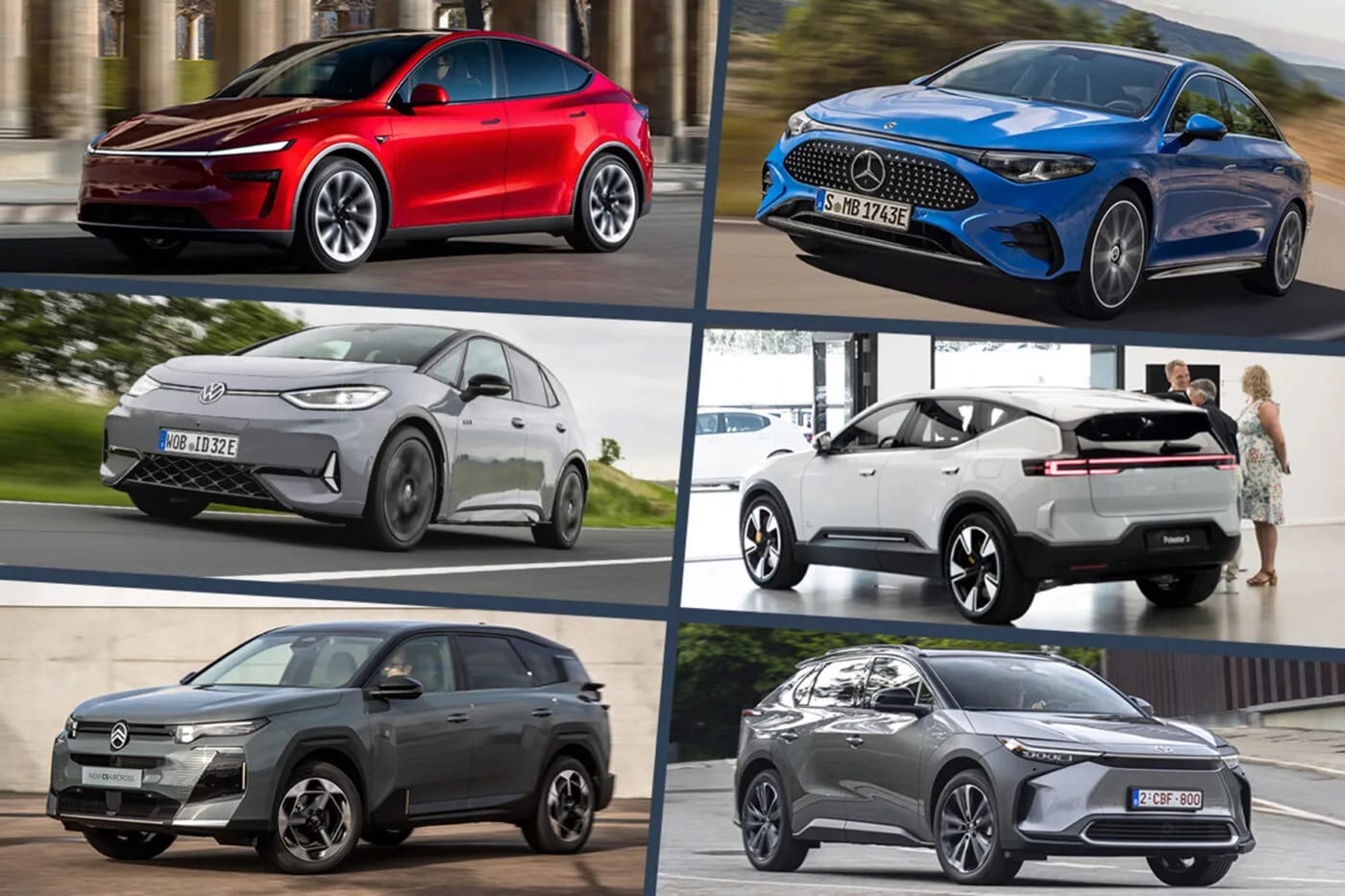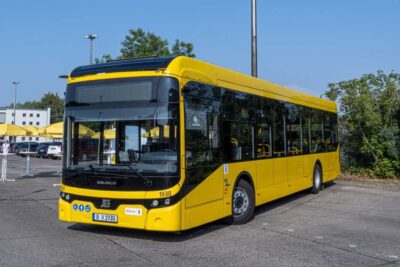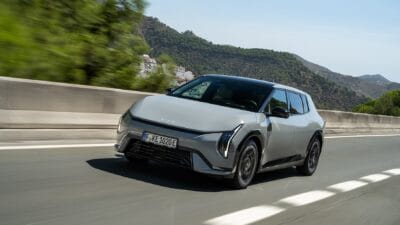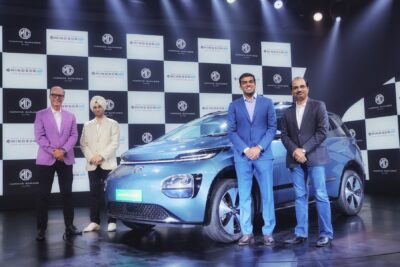
Half-year CO2 results: Suddenly, electric cars are gaining momentum
The International Council on Clean Transportation (ICCT) has published detailed data on carmakers’ CO2 emissions for the first half of 2025: the average stands at 101 grams of carbon dioxide per kilometre (g CO2/km). That is nine per cent above the limit of 93 g CO2/km. This breach should actually trigger fines payable to the European Union. Due to the so-called flexibilisation, that will not happen. Moreover, the average figure is misleading, as BMW, for example, already meets the target, while Volkswagen still has a long way to go.
To understand what is going on, the CO2 fleet limit mechanism must first be explained.
Every newly registered passenger car in the European Economic Area (EEA) – that is the 27 EU states plus Iceland, Liechtenstein and Norway, but excluding Switzerland and the United Kingdom – has a CO2 value assigned. This is listed in Registration Certificate Part I (formerly vehicle registration document) under position V.7.
CO2 emissions are measured using WLTP
The CO2 value is determined on a test bench according to the Worldwide Harmonised Light Vehicle Test Procedure (WLTP) for the respective vehicle type. Electric cars have no direct emissions and thus zero grams of CO2. And no, this is not a distortion or shifting of figures, as the EU also regulates the fuel side via the Renewable Energy Directive (RED). In Germany, more than 60 per cent of electricity in 2025 came from renewables like wind, solar and hydro power.
Plug-in hybrids (PHEVs) take a special position: They go through the WLTP test cycle twice, once with a fully depleted battery—i.e., using the combustion engine—and once with a fully charged battery, effectively running purely on electric power. The results are weighted based on maximum electric range (Utility Factor); this mix leads to PHEVs having significantly lower CO2 values than comparable cars powered solely by petrol or diesel engines. At least in the WLTP procedure.
Between 2021 and 2024, the general limit was 95 g CO2/km, which had to be met every year.
| OEM | Targel | Juni 2025* | YTD 2025* | Eco-innocations | adj. YTD 2025* | Reference-Target 2025-2027* | ZLEV factor | Target 2025-2027* | Target Gap | Market Share |
|---|---|---|---|---|---|---|---|---|---|---|
| BMW | 0 % | 92 | 94 | 1 | 93 | 88 | 1.05 | 93 | 0 | 7 % |
| Kia | 4 % | 101 | 97 | 0,9 | 96 | 93 | 1 | 93 | 3 | 4 % |
| Mercedes-Volvo-Polestar | 4 % | 99 | 95 | 0.3 | 94 | 86 | 1.05 | 91 | 4 | 8 % |
| Hyundai | 6 % | 99 | 100 | 0.9 | 99 | 94 | 1 | 94 | 6 | 4 % |
| Renault | 6 % | 103 | 103 | 1.4 | 102 | 96 | 1 | 96 | 6 | 12 % |
| Tesla-Stellantis-Toyota | 7 % | 98 | 102 | 1.1 | 101 | 95 | 1 | 95 | 6 | 32 % |
| Average | 9 % | 100 | 102 | 1 | 101 | 93 | 1 | 93 | 9 | |
| SAIC | 12 % | 94 | 106 | 0 | 106 | 95 | 1 | 95 | 11 | 2 % |
| VW | 14 % | 104 | 106 | 1 | 105 | 92 | 1 | 92 | 19 | 27 % |
| Nissan | 31 % | 126 | 123 | 1.1 | 122 | 93 | 1 | 93 | 29 | 2 % |
*CO2 emissions in g/km according to WLTP
NEDC conversion, weight factor and pooling
Between 2025 and 2029, the limit will be reduced by 15 per cent. From 2030, the reduction must amount to 55 per cent compared to 2021–2024.
That the actual limit of 93 g CO2/km is only slightly below the previous 95 g CO2/km and not exactly 15 per cent lower relates to various allowances. This includes a generous conversion from the phased-out New European Driving Cycle (NEDC) to WLTP.
Another special rule is the weight factor: each manufacturer is assigned an individual limit based on average vehicle kerb weight. For 2021–2024, this meant a discount for brands with heavier cars.
Now the effect of the weight factor has reversed. While the Renault Group, with relatively light vehicles, has a limit of 96 g CO2/km from 2025, the BMW Group, with heavier cars, may emit no more than 88 g CO2/km.
Who pools with whom and for how much?
Pooling faces widespread criticism: each manufacturer may combine its fleet emissions with any other. These pools must be registered, but whether and what compensation payments take place between companies remains confidential and subject to contractual freedom.
Often, brands within a group pool together—as Volkswagen does. There is no obligation: Hyundai and Kia, for example, report separately despite belonging to the same group.
New and notable is the intention of Tesla, Stellantis and Toyota to pool together—more on this later. An established pool is Mercedes with Polestar and Volvo, which already have mutual stakes. This trio has the heaviest vehicles and therefore the strictest limit at 86 g CO2/km.
Theoretical high fines – practically none
The core issue is the threatened fines: 95 euros must be paid to Brussels per gram exceeded per car. Volkswagen delivered about 1.25 million cars in Europe in 2024. One gram excess would thus result in fines of nearly 120 million euros.
Spoiler: nobody has paid a single euro so far. Current indications suggest that will not change anytime soon. The often-cited revenues Tesla generates from selling CO2 certificates come almost exclusively from the US – not Europe.
Let’s now look at how the half-year balance pans out for different brands. The rule is: the more electric cars, the better.
BMW exemplary
Example BMW: as mentioned, the group with BMW and Mini brands exactly meets the weight-adjusted CO2 limit of 93 g/km. A perfect landing, so to speak. This works because many powerful and emission-intensive combustion vehicles have been newly registered alongside 25 per cent electric cars and 14 per cent PHEVs.
BMW is clearly on a successful path, and the Neue Klasse will accelerate this trend. Given this, CEO Oliver Zipse’s continued advocacy for alternatives to electric cars – from e-fuels to fuel cells – seems, at best, odd.
Volkswagen Group needs to catch up
The situation is quite different for Volkswagen. With 105 g CO2/km instead of the required 92, VW exceeds the limit by a hefty 14 per cent. That does not seem to align with its strong electric car sales; the Volkswagen Group with Audi, Škoda, Cupra and other brands dominates Germany’s top 10.
The reason: 18 per cent electric cars and nine per cent PHEVs is nice – but not enough. Not only VW’s electric cars are a hit with customers, but combustion engine cars like the new Tiguan and T-Roc sell well too. VW must sell many more electric cars to compensate. The small car offensive starting in 2026 is therefore essential.
Too few Teslas to offset Stellantis
A special case is the Tesla-Stellantis-Toyota pool. The average CO2 value is 101 g/km—seven per cent above the 95 g/km limit. The problem is multiple: Tesla has simply not sold enough electric cars in Europe to offset Stellantis and Toyota. Stellantis pursues a very cautious model strategy.
Electric cars in the price-sensitive segment, like the Citroën ë-C3, come with very high premiums compared to combustion engine C3 versions—sometimes over £6,000. These are deterrent offers. Stellantis may be banking on flexibilisation.
Joint accounting for 2025 to 2027
Flexibilisation is inspired by the UK, where fixed annual electric car quotas rise yearly. Since the industry fails to meet these, averaging over multiple years is allowed.
The EU has adopted this averaging approach. The original CO2 fleet mechanism requires the limit to be met each year. New is that the average across 2025 to 2027 counts. A weak 2025 can be offset by strong 2026 or 2027.
If Tesla, Stellantis and Toyota register a pool, internal negotiations remain private. According to Brussels sources, pooling is optional, not compulsory.
Pooling unattractive for Toyota
In other words, Toyota could accept slightly missing the 2025 target due to its six upcoming electric models and avoid pooling. On its own, the Japanese maker is just over the limit at 96 instead of 95 g CO2/km. It is plausible Toyota will leave the pool.
With the Urban Cruiser, revised bZ4X, C-HR+ and bZ4X Touring arriving from October, that should suffice. It is no secret that Hilux and Land Cruiser will join the range as electric models.
For Stellantis, the outlook remains grim, even pooling with Tesla isn’t enough.
Mercedes slightly delayed, Hyundai on track
Mercedes in the pool with Volvo and Polestar must make clear progress to reduce from 94 to 86 g CO2/km. Is the design to blame for poor EV sales? Probably: EQE and EQE SUV as well as EQS and EQS SUV have underperformed expectations. BMW’s strategy of transferring familiar styling to EVs might have worked better. An electric E-Class estate rather than the current PHEV diesel would help.
New 800-volt platform EVs like the CLA, GLC and VLE promise improvement soon. Mercedes currently also benefits from flexibilisation. Mercedes, Volvo and Polestar together sold 23 per cent EVs and 23 per cent PHEVs. That’s quite significant—statistically, remaining combustion models must be especially CO2 intensive, e.g. AMG models.
Less noticed but worth mentioning are Hyundai and Kia. The South Korean brands are on track in H1 2025 with 96 instead of 93 g CO2/km (Kia) and 99 instead of 94 g CO2/km (Hyundai). Electric models like the Hyundai Inster sell well. Upcoming releases like the Kia EV2, PV5 and Hyundai Ioniq 2 will boost this further—and they must.
The makers must not be penalised
Conclusion: Flexibilisation—joint CO2 accounting for 2025 to 2027—prevents several manufacturers from paying money or fines to the EU when pooling with others. But, as Jan Dornoff of ICCT notes, it also reduces industry ambition: “Since flexibilisation was decided in Q1, no increase in electric car share is observable.” Consequently, CO2 emissions are not falling further, says Dornoff, who regularly produces analyses.
In summary, the European CO2 fleet directive basically works. However, further weakening it would be a mistake. Manufacturers want planning certainty, which the EU limits provide. Further leniency would reward brands that have not acted consistently, and punish those with smart model policies. And that must not happen.




0 Comments